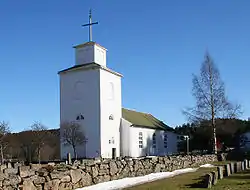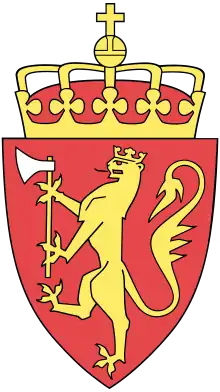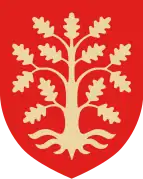Greipstad
Greipstad is a former municipality in the old Vest-Agder county, Norway. The 104-square-kilometre (40 sq mi) municipality existed from 1913 until its dissolution in 1964 when it became part of Songdalen municipality. The administrative centre of the municipality was the village of Nodeland where the Greipstad Church is located. The municipality is located in the northern part of the present-day municipality of Kristiansand in Agder county.[2]
Greipstad herred | |
|---|---|
 View of the local church in Nodeland | |
 Vest-Agder within Norway | |
 Greipstad within Vest-Agder | |
| Coordinates: 58°09′14″N 07°49′29″E | |
| Country | Norway |
| County | Vest-Agder |
| District | Sørlandet |
| Established | 1 Jan 1913 |
| Disestablished | 1 Jan 1964 |
| Administrative centre | Nodeland |
| Area | |
| • Total | 104 km2 (40 sq mi) |
| *Area at municipal dissolution. | |
| Population (1964) | |
| • Total | 2,061 |
| • Density | 20/km2 (51/sq mi) |
| Demonym(s) | Greipsdøling[1] |
| Time zone | UTC+01:00 (CET) |
| • Summer (DST) | UTC+02:00 (CEST) |
| ISO 3166 code | NO-1017 |
| Preceded by | Søgne in 1913 |
| Succeeded by | Songdalen in 1964 |
History
The municipality of Greipstad was established on 1 July 1913 when it was separated from the municipality of Søgne to form a municipality of its own. Initially, the municipality had a population of 822 residents. During the 1960s, there were many municipal mergers across Norway due to the work of the Schei Committee. On 1 January 1964, the municipality of Greipstad (population: 2,061) was dissolved and it was merged with most of the neighboring municipality of Finsland, excluding the area around Kleveland bru, (population: 797) and with the Eikeland area of Øvrebø municipality (population: 39) to form the new municipality of Songdalen.[3]
Name
The municipality (originally the parish) is named after the old Greipstad farm (Old Norse: Greipsstaðir), since that was the site of Greipstad Church. The first element of the name comes from the male name, Greipr, and the last element is stad which means "place".[2][4]
Government
All municipalities in Norway, including Greipstad, are responsible for primary education (through 10th grade), outpatient health services, senior citizen services, unemployment and other social services, zoning, economic development, and municipal roads. The municipality was governed by a municipal council of elected representatives, which in turn elected a mayor.[5]
Municipal council
The municipal council (Herredsstyre) of Greipstad was made up of representatives that were elected to four year terms. The party breakdown of the final municipal council was as follows:
| Party Name (in Norwegian) | Number of representatives | |
|---|---|---|
| Labour Party (Arbeiderpartiet) | 5 | |
| Centre Party (Senterpartiet) | 3 | |
| Liberal Party (Venstre) | 5 | |
| Total number of members: | 13 | |
| Party Name (in Norwegian) | Number of representatives | |
|---|---|---|
| Labour Party (Arbeiderpartiet) | 5 | |
| Farmers' Party (Bondepartiet) | 4 | |
| Liberal Party (Venstre) | 4 | |
| Total number of members: | 13 | |
| Party Name (in Norwegian) | Number of representatives | |
|---|---|---|
| Labour Party (Arbeiderpartiet) | 4 | |
| Farmers' Party (Bondepartiet) | 4 | |
| Liberal Party (Venstre) | 4 | |
| Total number of members: | 12 | |
| Party Name (in Norwegian) | Number of representatives | |
|---|---|---|
| Labour Party (Arbeiderpartiet) | 4 | |
| Joint List(s) of Non-Socialist Parties (Borgerlige Felleslister) | 8 | |
| Total number of members: | 12 | |
| Party Name (in Norwegian) | Number of representatives | |
|---|---|---|
| Labour Party (Arbeiderpartiet) | 5 | |
| Farmers' Party (Bondepartiet) | 4 | |
| Joint list of the Liberal Party (Venstre) and the Radical People's Party (Radikale Folkepartiet) | 3 | |
| Total number of members: | 12 | |
| Party Name (in Norwegian) | Number of representatives | |
|---|---|---|
| Labour Party (Arbeiderpartiet) | 4 | |
| Farmers' Party (Bondepartiet) | 4 | |
| Liberal Party (Venstre) | 4 | |
| Total number of members: | 12 | |
References
- "Navn på steder og personer: Innbyggjarnamn" (in Norwegian). Språkrådet.
- Store norske leksikon. "Greipstad – tidligere kommune" (in Norwegian). Retrieved 3 January 2017.
- Jukvam, Dag (1999). "Historisk oversikt over endringer i kommune- og fylkesinndelingen" (PDF) (in Norwegian). Statistisk sentralbyrå.
- Rygh, Oluf (1912). Norske gaardnavne: Lister og Mandals amt (in Norwegian) (9 ed.). Kristiania, Norge: W. C. Fabritius & sønners bogtrikkeri. p. 58.
- Hansen, Tore, ed. (12 May 2016). "kommunestyre". Store norske leksikon (in Norwegian). Kunnskapsforlaget. Retrieved 21 November 2020.
- "Kommunevalgene og Ordførervalgene 1959" (PDF) (in Norwegian). Oslo: Statistisk sentralbyrå. 1960. Retrieved 21 November 2020.
- "Kommunevalgene og Ordførervalgene 1955" (PDF) (in Norwegian). Oslo: Statistisk sentralbyrå. 1957. Retrieved 21 November 2020.
- "Kommunevalgene og Ordførervalgene 1951" (PDF) (in Norwegian). Oslo: Statistisk sentralbyrå. 1952. Retrieved 21 November 2020.
- "Kommunevalgene og Ordførervalgene 1947" (PDF) (in Norwegian). Oslo: Statistisk sentralbyrå. 1948. Retrieved 21 November 2020.
- "Kommunevalgene og Ordførervalgene 1945" (PDF) (in Norwegian). Oslo: Statistisk sentralbyrå. 1947. Retrieved 21 November 2020.
- "Kommunevalgene og Ordførervalgene 1937" (PDF) (in Norwegian). Oslo: Statistisk sentralbyrå. 1938. Retrieved 21 November 2020.

